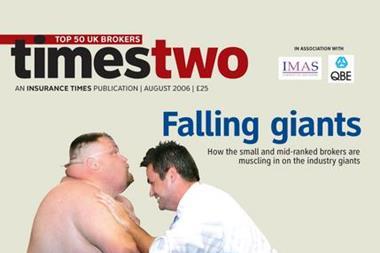David Ollerhead suggests a change strategy to give customers a better deal.
Remember the movie The Magnificent Seven? A besieged village seeks outside help to relieve itself from bandits. It winds up being helped by seven talented gunslingers, each with a different reason for responding to the villagers' urgent call.
Brokers besieged from all sides by competitive pressures, can sometimes seem a lot like that village.
But what your organisation needs is not seven magnificent sharpshooters, but rather seven magnificent strategies for success. Once you have them in place, you can start drawing way ahead of your competition.
The truth is that almost every organisation can do what it currently does more efficiently and more effectively, and this can give its customers a better deal.
Precisely what this 'better deal' for customers means will vary from one organisation to the next. But the very fact that you are thinking about and considering the treating customers fairly principles shows you are on the first rung of the ladder to ensure that your organisation becomes as successful as it can possibly be.
What you really need here is not reams and reams of guidance but, instead, a concise and focused game-plan.
Implementing the following seven strategies for success will give your organisation a superb chance of becoming a world-beating organisation.
No 1- Embrace change
If everything were perfect already, nothing would need to change. All the changes that have occurred throughout history have been designed to be improvements even if not every single one has turned out to be.
Asking yourselves questions such as how your organisation can improve what it does and how it can offer customers a better deal and win more loyalty from them are not questions that need to involve you in a frustrating period of introspection.
Instead, they are questions that will prove to be the crucible for the fire of your organisation's creativity and appetite for improvement. It's very likely you will already be aware of some areas of what your organisation does that could usefully be improved.
Let these only be the starting point of a creative initiative to change what needs to be changed.
Clarifying the vision is only the beginning, you need to be sure that everyone understands and buys in to your vision and that the performance objectives are clearly agreed, articulated and communicated.
No 2 - Engage your stakeholders
Your organisation has key stakeholders. These will include, but not be limited to, some or all of the following: the board of directors; shareholders; investors; managers; customers; the staff who deliver the process; suppliers; and anyone else with an interest in the organisation generally, and in its processes particularly.
An organisation is never going to be fulfilling its potential if it is not looking after its stakeholders' interests. Any process of intervention directed at maximising an organisation's potential needs to look hard at who an organisation's stakeholders are and develop ways of understanding and meeting their needs more effectively.
This will not be easy. Most people inside an organisation regard change with fear. They will usually see it as a threat to their job security and to their comfortable little niche within the organisation.
External stakeholders may also regard change as a risk. They need to be tactfully told, and also maybe shown, that the change will lead to a significant improvement at the organisation. Generally, of all an organisation's stakeholders both inside and outside the organisation, about one-quarter will typically be receptive to change while another quarter will be positively hostile to it.
The remaining 50% or so of people may very likely sit on the fence, which means that they may be amenable to change and may perhaps even support it if approached in the right way. You need to show people how change can minister to their own self-interest.
No 3 - Put your customers first
You all have customers. You exist, by definition, to meet the needs of those customers, or at least that's the theory of why your company exists.
The trouble is that after a while, organisations tend to lose their focus on customers. In fact, it may be that organisations enjoying some success are more likely to lose this focus on customers because they are not impelled by financial desperation to work out what they are doing wrong.
Accepting that your organisation must focus on the needs of customers is really only another way of saying that your organisation must embrace change. The reason for this is that the agenda of the customer, and the needs of the customer, will change.
Sometimes it is difficult to see whether change is being driven by the fact that customer needs change, or by new technology and resources becoming available. Perhaps the true nature of the driver is less important than the benefits your organisation is offering its customers.
Ultimately, your organisation's processes exist in order to deliver certain things to customers. Pursuing a policy of focusing your organisation's processes around your customers' needs is a rigorous discipline that can so often very constructively cut away superfluities and inefficiencies from your processes.
It's not usually enough simply to change the front end-processes which govern the direct interaction between the customer and your organisation's staff. Effecting change there and leaving everything else as it always has been is like putting a slick, streamlined, high-tech cockpit onto a plane and expecting it to fly properly.
The customer-facing processes are only part of the equation and they need to be supported and directed by other processes that themselves must be regularly reviewed.
No 4 - Prioritise your effort
A good starting point is to think of the three vital issues of quality, cost and time from the perspective of your customers. In other words: how can you improve the quality of what you deliver to your customers?
How can you deliver it to them in a way that is more cost-efficient for you, and more cost-effective for them? How can you deliver it to them sooner?
The gains would therefore relate to the same three variables of quality, cost and time, but focused around which is the most important to you.
Again, it's all about giving customers a better deal. The 'pain' consists essentially of the difficulties of effecting the changes in the process in question.
How can you assess gain and pain in advance? It would be misleading to suggest doing so is easy; it isn't. The way to do it is to work hard and thoughtfully with the project team. Look hard at the organisation from both a tactical and strategic perspective. Try to take every step that can be taken to understand where the gains and pains will arise. Make practical use of all the information you harvest, and keep on harvesting it.
It is highly logical - indeed essential - for an organisation to start a process of change directed at maximising potential by focusing on areas where the organisation will enjoy a high gain and a low pain.
To achieve changes here, the changes often have to be more revolutionary and will consequently contain far more risk. As for changes in the bottom left box, these belong to the 'you might as well have them' aspect of winning gains, and they should be pursued after the high gain boxes have been temporarily exhausted. They can also be good 'morale boosters' delivering quick wins to demonstrate that you mean business.
No 5 - Work together
In practice, it's very often the case that what is preventing an organisation achieving its potential is the fact that individual departments get more preoccupied with their own agendas than with giving their best to the organisation's customers.
This will usually manifest itself in communications problems between different departments that have the negative consequence of giving a worse service to customers than would ideally be the case. The solution is to ensure that each department knows precisely what deliverables are expected of them from the other.
Departments must also be encouraged to communicate with each other and to take vigorous efforts to understand one another's problems and not strive to run themselves as feudal empires in complete isolation from one another.
There are sometimes personal factors here that militate against departments giving their best to the organisation and playing their full role in contributing to the benefits the customer derives.
Individual managers in departments may, again, be accustomed to doing things in a certain way, with this certain way being more related to the agenda of those individual managers rather than customers.
Another problem is that organisations tend to be structured vertically in silos: ensuring that different departments' priorities and timeframes mesh satisfactorily may be far from easy.
Always remember that customers want (and are entitled to expect) instant results and they also want to experience a service level that is plainly focused around their own needs. Why shouldn't they? After all, they are spending their money. Departments that respond sluggishly to customer requirements are unlikely to contribute much to the organisation fulfilling itself.
No 6 - Devise a road map for change
You'd be mad to get in a car to take your family away on holiday without a map that'll show you where you're going.
You need a road map for the changes you want to engineer at your organisation, too.
How do you start drawing up this road map? Experience shows that you need to start by focusing on your organisation's processes.
A process at an organisation can be defined as a series of activities that produce a deliverable to meet one or more needs of the process customer.
Why is it so important to focus on processes when you are setting out to engineer change? Because, for one thing, your organisation's processes are, by definition, at the very heart of what you are about as an organisation.
For another thing, there is a refreshing objectivity about processes.
They can usually be investigated, looked at and refined without people feeling that they themselves are personally being told to change or in some way criticised.
Business processes are independent of emotions, or at least should be, and if you find that someone is clinging on to a particular part of a process and being possessive and emotional about it, that person just might have something to hide.
You need an objective, non-emotional roadmap for change, to ensure that your organisational family arrives at its destination safe and in good health.
You create a road map for change out of your business processes by investigating those existing processes carefully and drawing up details of how they can be improved - or if necessary discarded.
People too often see a process as an end in itself rather than a means to an end. Remember that processes exist purely to enable your organisation to deliver something of a certain quality and at a certain cost (for instance, to you and to your customer and at a certain time).
These three factors -- quality, cost and time - are all variables and are therefore all susceptible to improvement.
No 7 - It's people who make change happen
A key message of the movie The Magnificent Seven is that, as things turn out, the gunslingers are essentially a means to an end. The villagers only truly win liberation when they are banded together and work together.
In much the same way, change in organisations can only happen when the other strategies are used to mobilise the people in an organisation to change. Organisations are, clearly, composed of far more things than just people.
But while those things - such as buildings, ships, airplanes, chemical plants, international communication networks and so on - are the obvious visible assets of organisations, it's the people operating them who really matter.
The only real catalyst for change is people. Mobilise your people. Give them positive, solid and constructive reasons to change the way they do things. Make them want to make change happen. Make them want to be on your side. If you can do this, the sky really is the limit.
- David Ollerhead is a director of Decision Focus, a professional services consultancy that specialises in rapidly delivering performance improvement through process. DOllerhead@DecisionFocus.co.uk




































